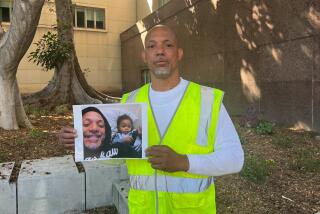CLIPBOARD : HOW TO PREVENT ACCIDENTAL POISONING
- Share via
According to David Harden of the UCI Medical Center Regional Poison Center, there is no such thing as a “poison-proof” home. “No matter what you do, there is always some chance that someone, especially a child, could be accidentally poisoned by substances that are common in most households,” he said. “But you can lessen the possibility by developing an awareness and practicing some routine preventive measures.”
There were more than 40,000 cases handled by the center last year. Sixty-seven percent of those cases involved children under age 6, and 92% of them occurred in the home. The most common cause was ingestion of prescription and non-prescription drugs. Cleaning agents and poisonous plants ranked second and third.
Harden, a public health educator, suggests taking a careful look at every room in your home, especially the kitchen, bathroom and garage, to make sure toxic substances are marked clearly and inaccessible to children. Here are some specific suggestions.
PREVENTION * Make sure prescription and non-prescription medicines are stored in their original containers with the original labels. Never switch medications from one bottle to another. Request child-resistant caps if there are small children in the home. Always put the cap back on medications before answering the telephone or doorbell. Instruct guests to follow similar precautions. * Throw out all outdated prescriptions. As a medicine gets older, its chemical composition can change. Flush all old drugs down the toilet. Rinse the container well, then discard. * Make sure drain cleaners, detergents, furniture polishes and other cleaning agents are stored in original containers. Don’t store toxic substances in drinking glasses or soda bottles. Store these items high, in a separate cabinet away from food. For added protection, install locks on cabinets that hold dangerous products. * Substances such as paint thinner, lighter fluid, gasoline and antifreeze that are common in most garages should be kept in a locked cabinet as well. Inform family members of their potential hazards. * Make sure everyone in the home knows the danger of mixing cleaning products. For example, bleach mixed with common household ammonia or toilet bowl cleaner creates potentially deadly toxic fumes. * When using paint, paint thinner or any household cleaning substance, wear gloves and work in a well-ventilated area. * Pets are also susceptible to accidental poisoning. Pelleted slug and snail killer resembles dog food and comes in similar packaging. It’s not unusual for dogs to become severely poisoned after consuming a bagful of snail killer. Store such products in a place where pets can’t get to them. When using them in the garden, keep pets away from treated areas. * Many house and garden plants are toxic if eaten, especially to children. The list includes such common garden species as azaleas, mushrooms, marigolds, Boston ferns and geraniums.
FIRST AID * If the victim is not breathing, is having seizures or has no pulse, call 911 immediately and administer CPR. * If poison has been inhaled, get the person into fresh air. Avoid breathing the fumes yourself. Open doors and windows wide. * For poison on the skin, remove contaminated clothing carefully and flood the area with water for 10 minutes. Wash gently with soap and water, then rinse. If the poison is a powder, brush it off before flooding the skin with water. * If the person has a poisonous substance in an eye, flood the eye with lukewarm water poured from a large glass 2 to 3 inches from the eye. Repeat for 15 minutes. Have the person blink frequently while flooding the eyes. Do not force the eyelid open. * If medicines have been swallowed, don’t give anything by mouth until you’ve called the Poison Center at the number listed below. If chemicals or household products have been swallowed, administer milk or water immediately, then call the Poison Center. * If a poisonous plant has been eaten, rinse the mouth and instruct the person to drink water. Save a portion of the plant for identification. Call the Poison Center. Watch for problems swallowing, breathing, increased drooling and skin irritation. * Always keep on hand a 1-ounce bottle of syrup of ipecac for each child in the home. The substance, available at drug stores without a prescription, is used to induce vomiting. Use only at the direction of the Poison Center or a physician.
ROUTES OF POISON EXPOSURE Ingestion: 78% Eye: 6% Inhalation: 6% Skin: 6% Bites & Stings: 4%
The Poison Center’s 24-hour, toll-free number is (800) 544-4404. It distributes information packets with additional information on prevention, first aid and poisonous plants. To order, call (714) 937-7688, or write to the UCI Medical Center Regional Poison Center at 101 The City Drive, Orange, 92668-3298. The center’s services are free, but a donation of $1 to $10 in exchange for an information packet is appreciated.
For more information on animal poisoning, call the National Animal Poison Control Center’s 24-hour hot line, (800) 548-2423. This service, sponsored by the University of Illinois College of Veterinary Medicine, charges a $25-per-case fee payable by credit card. For a brochure, write to the center at 2001 S. Lincoln Ave., Urbana, Ill., 61801.
Source: UCI Medical Center Regional Poison Center


